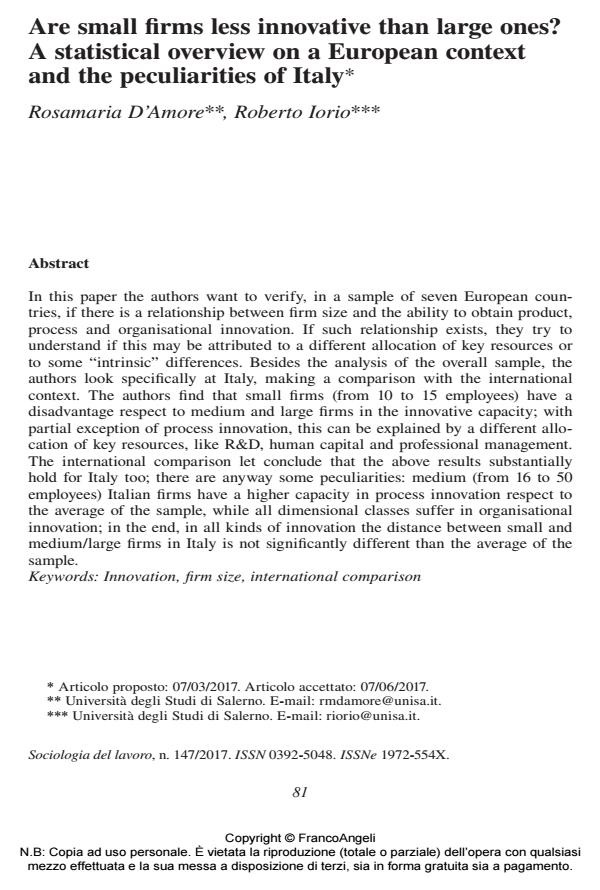Are small firms less innovative than large ones? A statistical overview on a European context and the peculiarities of Italy
Journal title SOCIOLOGIA DEL LAVORO
Author/s Rosamaria D’Amore, Roberto Iorio
Publishing Year 2017 Issue 2017/147
Language English Pages 27 P. 81-107 File size 170 KB
DOI 10.3280/SL2017-147005
DOI is like a bar code for intellectual property: to have more infomation
click here
Below, you can see the article first page
If you want to buy this article in PDF format, you can do it, following the instructions to buy download credits

FrancoAngeli is member of Publishers International Linking Association, Inc (PILA), a not-for-profit association which run the CrossRef service enabling links to and from online scholarly content.
In this paper the authors want to verify, in a sample of seven European countries, if there is a relationship between firm size and the ability to obtain product, process and organisational innovation. If such relationship exists, they try to understand if this may be attributed to a different allocation of key resources or to some "intrinsic" differences. Besides the analysis of the overall sample, the authors look specifically at Italy, making a comparison with the international context. The authors find that small firms (from 10 to 15 employees) have a disadvantage respect to medium and large firms in the innovative capacity; with partial exception of process innovation, this can be explained by a different allocation of key resources, like R&D, human capital and professional management. The international comparison let conclude that the above results substantially hold for Italy too; there are anyway some peculiarities: medium (from 16 to 50 employees) Italian firms have a higher capacity in process innovation respect to the average of the sample, while all dimensional classes suffer in organisational innovation; in the end, in all kinds of innovation the distance between small and medium/large firms in Italy is not significantly different than the average of the sample.
Keywords: Innovation, firm size, international comparison
- Acs Z.J., Audretsch D.B. (1988). Innovation in Large and Small Firms: An Empirical Analysis. The American Economic Review, 78(4): 678-690.
- AECA (Asociación Española de Contabilidad y Administración de Empresas) (1995). Principios de Organización y Sistemas 2. Innovación en la empresa: factor de supervivencia. Documento 7, Second edition.
- Archibugi D., Howells J., Michies J., eds. (1998). National Systems of Innovation or the Globalization of Technology? Cambridge: Cambridge University Press.
- Audretsch D. (1991). New-Firm Survival and the Technological Regime. The Review of Economic and Statistics, 73(1): 441-450.
- Baldwin W., Lin Z. (2002). Impediment to Advanced Technology Adoption for Canadian Manufacturers. Research Policy, 31: 1-18. DOI: 10.1016/S0048-7333(01)00110-X
- Bauman J., Kritikos A. (2016). The Link Between R&D, Innovation and Productivity: Are Micro Firms Different? Research Policy, 45: 1263-1274.
- Breschi S., Malerba F. (1997). Sectoral Innovation Systems: Technological Regimes, Schumpeterian Dynamics and Spatial Boundaries. In: Edquist C., ed., Systems of Innovations: Technologies, Institutions and Organizations. London: Pinter Publishers.
- Bugamelli M., Cannari L., Lotti F., Magri S. (2012). Il gap innovativo del sistema produttivo italiano: radici e possibili rimedi. Questioni di Economia e Finanza. Occasional papers, Banca d’Italia, n. 121.
- D’Amore R., Iorio R., Lubrano-Lavadera G. (2017). Exploring the Relationship Between Human Capital and Innovation at a Firm Level. A Study on a Sample of European Firms. CELPE Discussion Paper, 144.
- Evangelista R., Mastrostefano V. (2006). Firm Size, Sectors and Countries as Sources of Variety in Innovation. Economics of Innovation and New Technology, 15(3): 247-270. DOI: 10.1080/10438590500160990
- Freeman C. (1974). The Economics of Industrial Innovation. London: Penguin Modern Economic Texts.
- Galia F., Legros D. (2004). Complementarities Between Obstacles to Innovation: Evidence from France. Research Policy, 33: 1185-1199.
- Giunta A., Rossi S. (2017). Che cosa sa fare l’Italia. Bari: Laterza.
- Hausman A. (2005). Innovativeness Among Small Businesses: Theory and Propositions for Future Research. Industrial Marketing Management, 34: 773-782.
- Istituto Guglielmo Tagliacarne-Focus PMI (2014). Le tendenze innovative della piccola e media imprenditoria italiana.
- Keklik M. (2002), Schumpeter, Innovation and Growth: Long-cycle dynamics in the post-WWII American manufacturing industries. Hampshire, England: Ashgate.
- Madrid-Guijarro A., Garcia D., Van Auken H. (2009). Barriers to Innovation among Spanish Manufacturing Firms. Journal of Small Business Management, 47(4): 465-488.
- Malerba F. (2002). Sectoral Systems of Innovation and Production. Research Policy, 31: 247-264. DOI: 10.1016/S0048-7333(01)00139-1
- Malerba F., Orsenigo L. (1993). Technological Regimes and Firm Behaviours. Industrial and Corporate Change, 2: 45-71.
- Nelson R., Rosenberg N. (1993). Technical Innovation and National Systems. In: Nelson R., ed., National Innovation Systems. A Comparative Analysis. New York: Oxford University Press.
- OECD (2007). Innovation and Growth. Rationale for an Innovation Strategy.
- Onida F. (2004). Se il piccolo non cresce. Bologna: il Mulino.
- Rothwell R., Dodgson M. (1994). Innovation and Size of Firm. In: Rothwell R., Dodgson M., eds., The handbook of industrial innovation. London: Elgar: 310-324.
- Schumpeter J.A. (1912). The Theory of Economic Development. Oxford: Oxford University Press.
- Schumpeter J.A. (1942). Capitalism, Socialism and Democracy. New York: Harper.
- Storey J. (2000). The Management of Innovation Problem. International Journal of Innovation Management, 4(3): 347-369. DOI: 10.1142/S1363919600000196
- Tourigny D., Le C. (2004). Impediments to Innovation Faced by Canadian firms. Economics of Innovation and New Technology, 13(3): 217-250. DOI: 10.1080/10438590410001628387
Rosamaria D’Amore, Roberto Iorio, Are small firms less innovative than large ones? A statistical overview on a European context and the peculiarities of Italy in "SOCIOLOGIA DEL LAVORO " 147/2017, pp 81-107, DOI: 10.3280/SL2017-147005